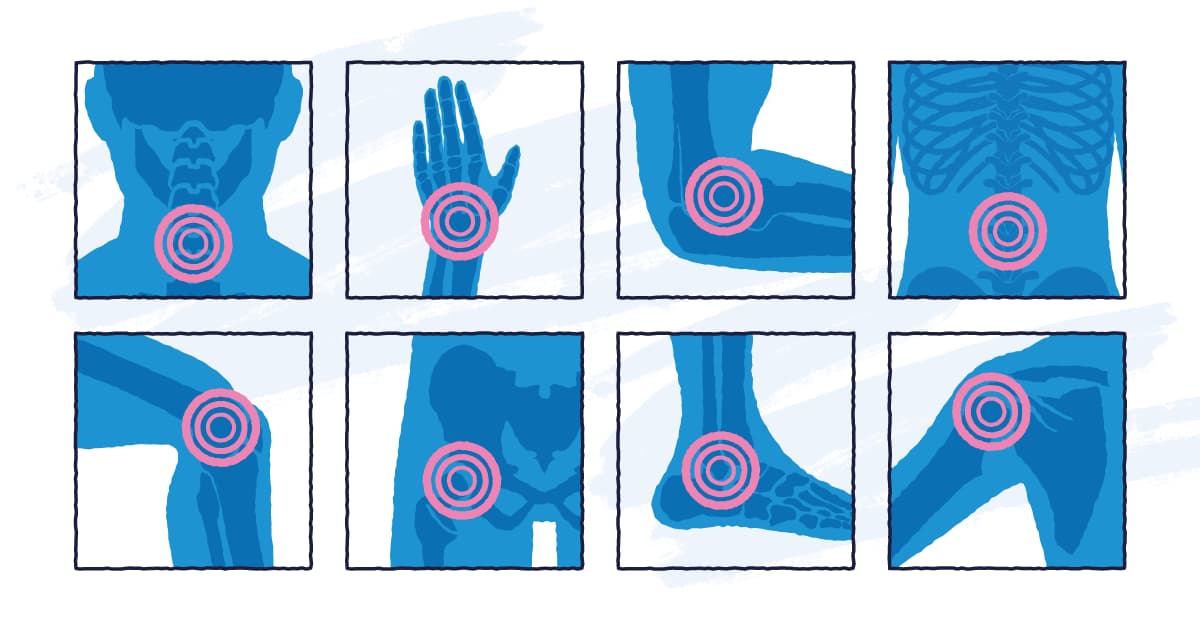Osteoarthritis is the most common form of arthritis, and affects millions of people all over the world. It’s a condition that causes stiff and painful joints, from mild discomfort to debilitating pain that can impact everyday life.
What is osteoarthritis?
Osteoarthritis occurs when the cartilage that cushions your joints degrades and wears out over time. In a healthy joint, the cartilage forms a hard, smooth surface for the bones to move freely in multiple directions (depending on the type of joint). As osteoarthritis advances, it causes this barrier to become thinner until bone is rubbing on bone.
This can lead to inflammation of the joints and connective tissues, causing the area to become red and swollen, as well as causing pain and reduced mobility.
It can occur in almost any joint in the body
Osteoarthritis symptoms

The symptoms of osteoarthritis usually develop slowly over a long time, getting worse and more noticeable as the condition advances. The severity of symptoms can be very different between different people, with some people only experiencing relatively mild pain or joint trouble, while it may be more intense for others.
Pain – the joint or joints where the arthritis is present will become painful when you move
Stiffness – joints will become difficult to move
Grating noise – when you move the joint you can hear a grinding or crackling sound
Redness and swelling – the soft tissues of the affected joints can become inflamed
If you experience any of these symptoms and they don’t go away, you should make an appointment to see your doctor so they can determine if its osteoarthritis
Osteoarthritis causes
There’s no exact cause known for osteoarthritis, but age is the biggest factor in its development. Your joints are exposed to movement and wear and tear every day, but any damage Is repaired by your body. This ability to repair the damage seems to diminish as we age.
While we don’t know of the exact cause, there are risk factors that can increase the chances of developing osteoarthritis
Risk factors
Injuries – if you’ve previously injured a joint and not given it the time to heal
Family history – this can increase your risk, but it’s not known why
Other arthritis – if a joint is already affected by existing conditions such as rheumatoid arthritis or gout
Obesity – excessive weight can put more strain on joints such as knees and hips Osteoarthritis treatment While there’s no direct treatment for osteoarthritis, there are things you can do to manage the condition, and even improve it with milder cases. In many cases, it’s possible to stop the condition from progressing and getting worse. Painkillers can also help with decreasing discomfort when doing everyday activities, or even adding supplements to your diet such as fish oil.
If you only have a mild case of osteoarthritis, lifestyle changes could help to manage or improve symptoms, such as:
- losing weight
- increasing exercise
- wearing certain supportive clothes or shoes
- physical or occupational therapy
In more severe cases, surgery can sometimes be an option to repair or strengthen a joint, such as replacing it with an artificial one, or temporarily relieve severe pain with an injection such as cortisone.
Common examples of this would be a hip replacement or a knee replacement, which can repair or replace the arthritic joints to reduce pain and improve mobility.
Orthopaedics at Ramsay Health Care
You’ll find a full range of treatments, advice, and support at you nearest Ramsay hospital, covering knee and hip surgery as well as back and spine problems, shoulders and elbows, hands, wrists, and more.
If you’re experiencing problems with arthritis and joint pain, don’t hesitate to get in touch with us today to make an appointment or speak to us about your options.